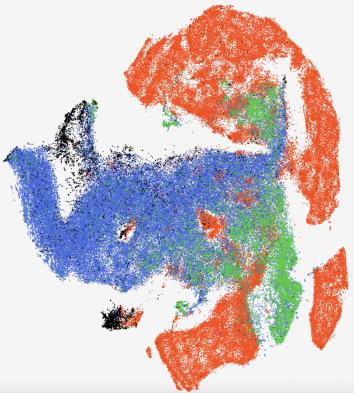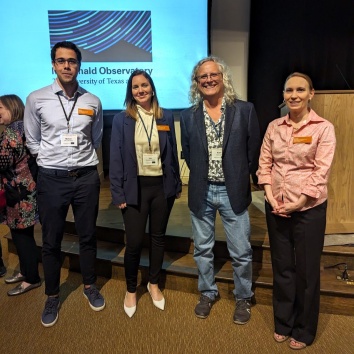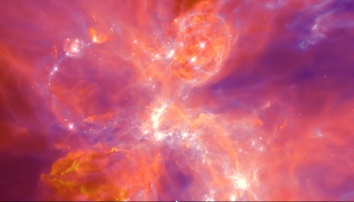
Data visualization, the product of unsupervised machine learning, exploring patterns of a HETDEX dataset. Image credit: Mahan Mirza Khanlari / HETDEX.
16 May 2024
The 2024 Board of Visitors Winter Meeting took place February 23-24 at The University of Texas at Austin. Over 150 Board of Visitors members attended.
Through a series of talks, the event explored some of the ways artificial intelligence (AI) is making an impact within UT’s Astronomy Department and McDonald Observatory, and how it may shape the future of scientific research.
Throughout 2024, as part of its Year of AI initiative, The University of Texas at Austin will host events, programs, and partnerships that highlight and advance the groundbreaking research in artificial intelligence underway at the University. This year’s Board of Visitors Winter Meeting was one such event.
Artificial intelligence is technology that enables computer systems to learn, read, write, create, and analyze. It holds incredible promise for the field of astronomy. By removing “junk” from data sets, identifying patterns, and making predictions, it will accelerate the timeline of discovery. We are excited to see what new horizons it will open to us.
The Board of Visitors is one of The University of Texas at Austin’s oldest and most respected donor groups. Members live across Texas and beyond, united by a love of and commitment to the field of astronomy and the McDonald Observatory.
Over time, Board of Visitors members have helped us accomplish great things through their generous contributions. This ranges from funding chairs, professorships, and graduate student fellowships, to helping with private contributions to build the magnificent Hobby-Eberly Telescope, the Frank N. Bash Visitors Center, and more.
To learn about ways to support the Observatory, visit mcdonaldobservatory.org/support.
Faculty Talk: Harnessing Explainable AI in Modern Astronomy
Arya Farahi, Assistant Professor, Statistics and Data Science
“AI can help us sort through data, find data, make estimations, and bridge the gap between theory and experiment.”
With explainable artificial intelligence (XAI), AI systems share the logic and data they use to generate results. Farahi discussed how XAI is well suited to exploring astronomical problems, which can have many hypotheses and limited observational data. Sharing the logic and data behind AI-generated results allows astronomers to more easily accept or reject them. This plus the overall speed and scope possible with AI-enhanced experiments is accelerating scientific discovery in the field.
Research Scientist Talk: How a Past Board of Visitors Meeting Fostered a HETDEX-AI Collaboration
Erin Mentuch Cooper, Research Scientist
“We’re really searching for that needle in the haystack. We need help, and we need help from artificial intelligence.”
The Hobby-Eberly Telescope Dark Energy Experiment (HETDEX) is mapping the position of over one million galaxies. For this endeavor, it has gathered over 500 million optical spectra to date. That’s a lot of data to sift through. Mentuch Cooper shared how a collaboration with Synthetaic AI – made possible by a Board of Visitors introduction – has transformed the project’s data processes. Thanks to Synthetaic AI, HETDEX now uses artificial intelligence to sort data with greater speed and accuracy than would otherwise be possible. This includes identifying and removing contaminants such as meteors, satellites, and other anomalies.
Undergraduate Student Talk: Application of Machine Learning in HETDEX
Mahan Mirza Khanlari, Undergraduate Student
“If you were to sort through 1 billion spectra manually, you’d probably evolve into a new species by the time you were done. We let the machines do the heavy lifting.”
With the growing wealth of astronomical data available to astronomers, machine learning is becoming a vital tool to make the most of it all. Mirza Khanlari discussed the customized machine learning software the HETDEX team uses to categorize data. By visually clumping together similar spectra, the software allows the team to quickly identify useful objects such as stars, galaxies, and black holes, and remove false positives from HETDEX data. This has opened up the option to study fainter objects in the Universe while maintaining a more pristine sample set of galaxies.
The Great Lecture: Advancing New Frontiers in Astronomy Data Analysis, Modeling, and Discovery with Artificial Intelligence
Stella Offner, Associate Professor
“Some of you may have the Terminator in mind when you think about AI. But I’m here to tell you that when we apply AI in science and astronomy, it’s much less scary.”
Watch Dr. Offner’s lecture on YouTube
As much as astronomy will benefit from the AI revolution, so too will AI benefit from astronomy. The field provides large, publicly available datasets and a low risk setting within which to practice problem solving. Through the STARFORGE project, Offner uses AI to study the star formation process. She shared how the team is using AI techniques, combined with numerical simulations and theoretical models, to cut through the messiness of observations and provide insights on fundamental star formation questions. Offner also shared how generative AI (the most famous example being ChatGPT) can help astronomers further their research by answering prompts, drawing from scientific sources, and providing links to research.

Data visualization, the product of unsupervised machine learning, exploring patterns of a HETDEX dataset. Image credit: Mahan Mirza Khanlari / HETDEX.

From left to right: Mahan Mirza Khanlari, Erin Mentuch Cooper, Karl Gebhardt, and Stella Offner. Image credit: Cara Arlauskas / McDonald Observatory.

Still from a STARFORGE simulation of star formation. Image credit: Michael Grudic and the STARFORGE Collaboration.